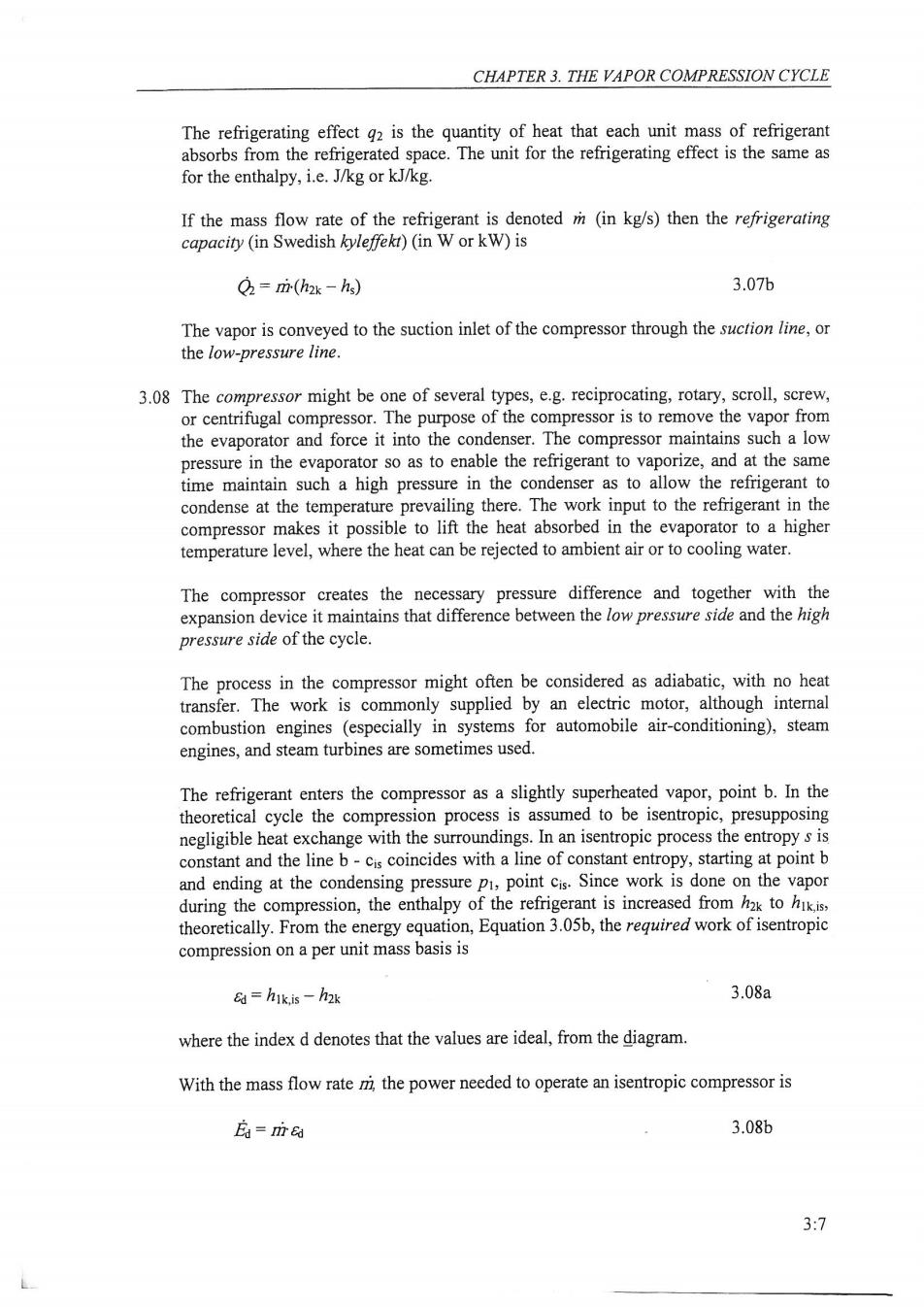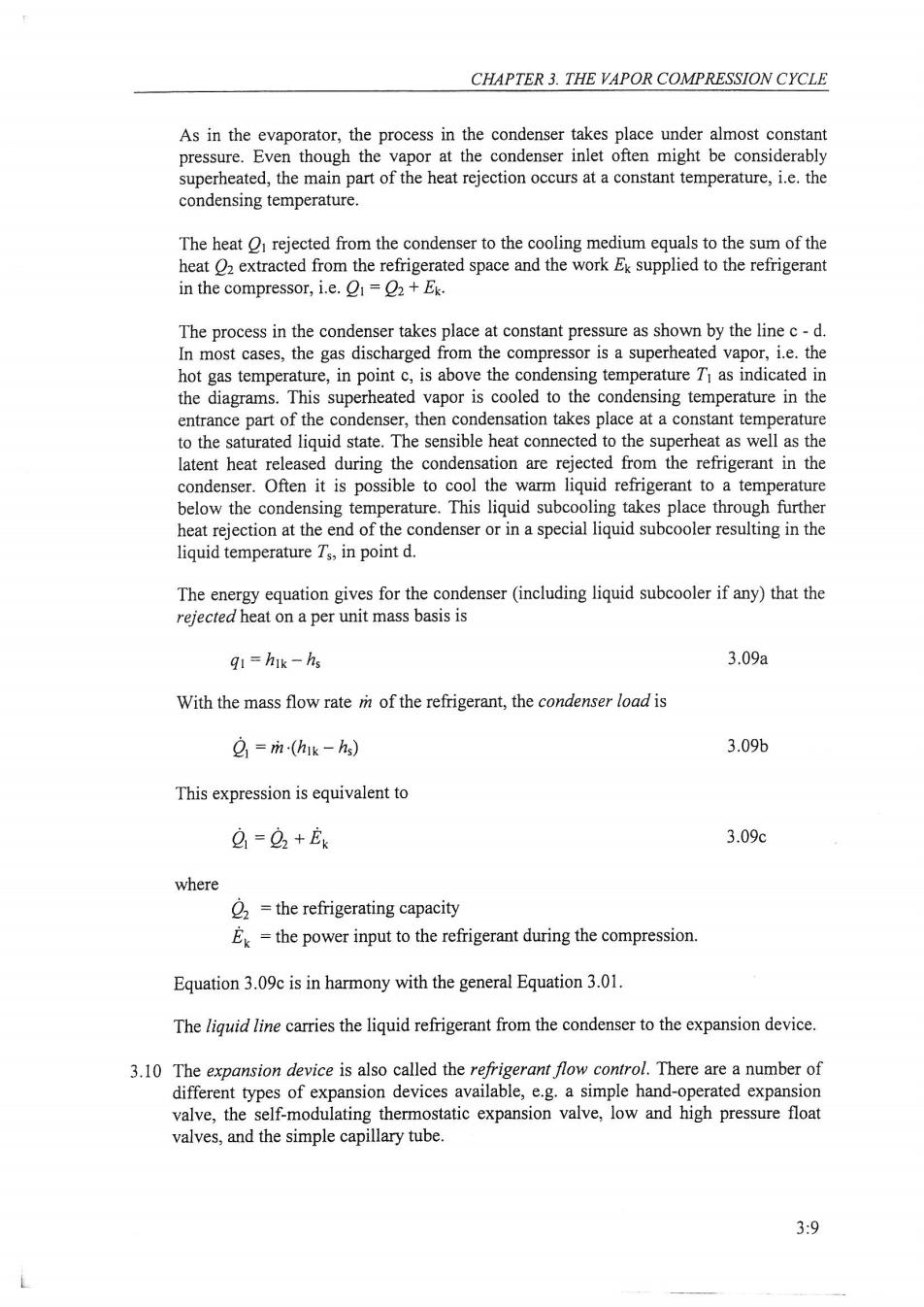
REFRIGERATING ENGINEERING p C d T T P 6 T P2 a a ha=h。=h 92 9 h 片 h h2 hax k Fig.3.06.The simple cycle in T-s and p-h diagrams. The pressure in the evaporator is called the evaporating pressure.For a pure refrigerant, a certain evaporating pressure corresponds to a specific evaporating temperature according to the vapor pressure curve,the relation between saturated vapor pressure and temperature.Figure 3.03 illustrates this relation for some refrigerants. For example with ammonia,NH3,as the refrigerant,and presuming that the compressor maintains the evaporating pressure equal to 2,9 bar,then the evaporating temperature will be-10C.The evaporating temperature will decrease if the evaporating pressure is depressed. Under steady-state conditions,the evaporator is supplied with a continuous flow of refrigerant which is vaporized successively by the heat transferred from the refrigerated space.The pressure drop in the flow direction of the refrigerant is normally small and, consequently,the heat transfer to the refrigerant takes place under essentially constant pressure and constant temperature. In the evaporator it is a constant-pressure,almost constant-temperature process, indicated by the line a-b in the diagrams.At the inlet to the evaporator,point a,the refrigerant consists of a mixture of saturated liquid and saturated vapor having the average enthalpy hs.Heat transfer from the refrigerated space causes the liquid to evaporate and change the mixture of liquid and vapor into a saturated vapor.In practice, however,the cold vapor usually will continue to absorb heat from the refrigerated space and become slightly superheated before it leaves the evaporator.At the outlet,point b, the enthalpy is hak. According to the energy equation,Equation 3.05b,with=0 for the evaporator,the refrigerating effect (in Swedish koldalstring)is 92=h2k-hs 3.07a 3:6

CHAPTER 3.THE VAPOR COMPRESSION CYCLE The refrigerating effect g2 is the quantity of heat that each unit mass of refrigerant absorbs from the refrigerated space.The unit for the refrigerating effect is the same as for the enthalpy,i.e.J/kg or kJ/kg If the mass flow rate of the refrigerant is denoted m (in kg/s)then the refrigerating capacity (in Swedish kyleffekt)(in W or kW)is Q=m(hak-hs) 3.07b The vapor is conveyed to the suction inlet of the compressor through the suction line,or the low-pressure line. 3.08 The compressor might be one of several types,e.g.reciprocating,rotary,scroll,screw, or centrifugal compressor.The purpose of the compressor is to remove the vapor from the evaporator and force it into the condenser.The compressor maintains such a low pressure in the evaporator so as to enable the refrigerant to vaporize,and at the same time maintain such a high pressure in the condenser as to allow the refrigerant to condense at the temperature prevailing there.The work input to the refrigerant in the compressor makes it possible to lift the heat absorbed in the evaporator to a higher temperature level,where the heat can be rejected to ambient air or to cooling water. The compressor creates the necessary pressure difference and together with the expansion device it maintains that difference between the low pressure side and the high pressure side of the cycle. The process in the compressor might often be considered as adiabatic,with no heat transfer.The work is commonly supplied by an electric motor,although internal combustion engines (especially in systems for automobile air-conditioning),steam engines,and steam turbines are sometimes used. The refrigerant enters the compressor as a slightly superheated vapor,point b.In the theoretical cycle the compression process is assumed to be isentropic,presupposing negligible heat exchange with the surroundings.In an isentropic process the entropy s is constant and the line b-cis coincides with a line of constant entropy,starting at point b and ending at the condensing pressure pi,point cis.Since work is done on the vapor during the compression,the enthalpy of the refrigerant is increased from hak to hIk is, theoretically.From the energy equation,Equation 3.05b,the required work of isentropic compression on a per unit mass basis is Ed=h1k.is -h2k 3.08a where the index d denotes that the values are ideal,from the diagram. With the mass flow rate m,the power needed to operate an isentropic compressor is 店=ia 3.08b 3:7

REFRIGERATING ENGINEERING In reality,additional work is required to compensate for mechanical friction,fluid friction,and other losses in the compressor.Let us define a total isentropic compression efficiency as mk =Edl ak or ak=Edl mk 3.08c where a is the actual work that must be supplied to the shaft of the compressor. Hence the actual compressor power is 民=i/Tk 3.08d The efficiency nk often is in the range 0,6-0,8,and with an adequate knowledge of the magnitude in an actual case,the outlet state c from the compressor can be established when the inlet state b is known. It is often of interest to calculate the outlet conditions from the compressor.If the compressor operates adiabatically,i.e.without any heat transfer to or from the sur- roundings,we have hik=hak +a or hik=h2k+&m 3.08e where hik is the enthalpy of the refrigerant at the true outlet state from the compressor. Combining this with Equation 3.08a we can also write hik =h2k +(hik.is -h2k)/m 3.08f If the compressor is non-adiabatic,i.e.some heat transfer occurs,the Equations 3.08c-f must be modified according to Equation 3.05b. The discharge line,or the hot gas line,delivers the high pressure,high temperature vapor from the compressor to the condenser. 3.09 The condenser might be air cooled or water cooled or a combination thereof.The refrigerant condenses in the condenser.The pressure of the vapor will be so high that the available cooling medium can be used to bring the vapor to condensation.To enable this heat transfer,from the refrigerant to the cooling medium,the condensing temperature must be higher than the temperature of the cooling medium.With the relation between saturated vapor pressure and temperature,Figure 3.03,it is possible to determine the necessary condensing pressure. For example if the condensing temperature is supposed to be +30C,using ammonia as the refrigerant,the compressor has to maintain a pressure equal to 11,7 bar in the condenser. 3:8

CHAPTER 3.THE VAPOR COMPRESSION CYCLE As in the evaporator,the process in the condenser takes place under almost constant pressure.Even though the vapor at the condenser inlet often might be considerably superheated,the main part of the heat rejection occurs at a constant temperature,i.e.the condensing temperature. The heat O rejected from the condenser to the cooling medium equals to the sum of the heat 2 extracted from the refrigerated space and the work Ek supplied to the refrigerant in the compressor,i.e.1=2+Ek. The process in the condenser takes place at constant pressure as shown by the line c-d. In most cases,the gas discharged from the compressor is a superheated vapor,i.e.the hot gas temperature,in point c,is above the condensing temperature Ti as indicated in the diagrams.This superheated vapor is cooled to the condensing temperature in the entrance part of the condenser,then condensation takes place at a constant temperature to the saturated liquid state.The sensible heat connected to the superheat as well as the latent heat released during the condensation are rejected from the refrigerant in the condenser.Often it is possible to cool the warm liquid refrigerant to a temperature below the condensing temperature.This liquid subcooling takes place through further heat rejection at the end of the condenser or in a special liquid subcooler resulting in the liquid temperature Ts,in point d. The energy equation gives for the condenser(including liquid subcooler if any)that the rejected heat on a per unit mass basis is gi=hik-hs 3.09a With the mass flow rate m of the refrigerant,the condenser load is e=m(hik-hs) 3.09b This expression is equivalent to ②=92+Ek 3.09c where =the refrigerating capacity Er=the power input to the refrigerant during the compression. Equation 3.09c is in harmony with the general Equation 3.01. The liguid line carries the liquid refrigerant from the condenser to the expansion device. 3.10 The expansion device is also called the refrigerant flow control.There are a number of different types of expansion devices available,e.g.a simple hand-operated expansion valve,the self-modulating thermostatic expansion valve,low and high pressure float valves,and the simple capillary tube. 3:9

REFRIGERATING ENGINEERING The purpose of any expansion device is twofold: to accomplish the throttling process and maintain the pressure difference between the condenser and the evaporator to adjust the refrigerant flow rate to the evaporator;keeping the evaporator filled with refrigerant liquid,yet preventing the liquid to be carried over to the compressor where it might cause damages through liquid hammer. By this uncomplicated expansion device,the pressure as well as the temperature can be reduced from the level existing in the condenser (including subcooler)to the level wanted in the evaporator. As mentioned earlier,the cycle has a high pressure side and a low pressure side,and the boundary line is at the expansion device and the compressor. The entire heat extraction,i.e.the refrigerating effect,occurs on the low pressure side of the cycle,and the heat rejection takes place on the high pressure side. The process in the expansion valve completes the cycle.Here a throttling process takes place and we obtain the well known condition that the enthalpy of the refrigerant has the same value before and after the reduction of the pressure.This relation is readily obtained from the energy equation,Equation 3.05b,with q=0 and &=0,leaving ha=ha 3.10 Such a process is usually referred to as a throttling process.The thermodynamic state at the outlet of the expansion valve,i.e.the inlet to the evaporator,is located in the diagram by following the line of constant enthalpy from point d to the intersection with the line representing the evaporating pressure,point a. The pressure of the refrigerant is reduced in the throttling process and the liquid begins to vaporize,and a portion of the liquid turns into vapor.This portion must be supplied with the latent heat of vaporization.This energy is taken from the fluid itself,resulting in a reduction of the temperature,from Ts to T2.The low temperature of the cycle is created in the expansion device! Normally,the expansion valve is installed close to the evaporator,and when the refrigerant passes through the valve,we have completed one loop of the cycle,and the course of events will repeat again. (Equation 3.10 does not hold for one of the most frequent applications,namely household refrigerators.These domestic units are usually equipped with a capillary tube where the refrigerant in the expansion process is brought into heat exchange with the vapor leaving the evaporator.To analyze this we have to apply Equation 3.05b and the situation resembles that which is treated in sections 3.41-42.) 3.11 State point a represents a mixture of saturated liquid,at state a',and saturated vapor,at state a".Calculations on thermodynamic properties of such mixtures are strongly simplified through the introduction of the concept quality of the mixture,defined as the 3:10